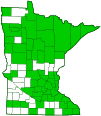Shaggy Mane
(Coprinus comatus)
Conservation • Description • Habitat • Ecology • Distribution • Taxonomy
Conservation Status |
|||
| IUCN Red List | not listed |
||
| NatureServe | NNR - Unranked |
||
| Minnesota | not listed |
||
Description |
Shaggy Mane is a common and widespread mushroom easily recognized by it’s shape and it’s shaggy, dissolving cap. It is one of the “Foolproof Four”, the four most easily identified mushrooms. It is found either singly or in clusters, lines, or rings. It obtains its nutrients from decaying organic matter (saprobic). It usually appears in the summer and fall, but may also appear in the spring. The cap when young is whitish with a brownish center, smooth, and dry. It is oval to cylinder-shaped, 2″ to 5½″ tall, and 1″ to 2″ wide, covering most of the stalk. As it matures it becomes bell-shaped with spreading and uplifted margins and large, shaggy scales. As it ages the margins dissolve progressively upward into black ink at that drips to the ground. The entire cap dissolves in a little as 24 hours. The gills are white, closely spaced, and are not attached to the stalk. As they mature they quickly turn pink then black. As they release their spores they self-digest, turning into black ink at that drips to the ground. The stalk is white, smooth, hollow, usually 2″ to 6″ tall, and ⅜″ to ⅝″ wide. Large individuals may be up to 8″ tall and ¾″ wide. At the base of the stalk is a slightly bulbous, cup-like structure (volva). This is a remnant of a protective, egg-like covering (universal veil) that completely envelopes the developing mushroom when young. It may be partially or completely buried in the ground. It adheres tightly to the stalk and is not sack-like. Toward the top of the stalk, below the cap and gills, is a membranous ring. This is the remnant of a protective covering (inner veil) of the developing gills. The spores are black. It has a mild, pleasant odor when young. |
Similar Species |
Habitat and Hosts |
Lawns, gravel roads, disturbed sites. |
Ecology |
Season |
Usually summer and fall, sometimes spring. |
Distribution |
||
|
Sources Biodiversity occurrence data published by: Minnesota Biodiversity Atlas (accessed through the Minnesota Biodiversity Atlas Portal, bellatlas.umn.edu, 9/19/2025). |
|
| 9/19/2025 | ||
Occurrence |
||
Common and widespread |
||
Taxonomy |
|
| Kingdom | Fungi (Fungi) |
| Subkingdom | Dikarya |
| Phylum | Basidiomycota (Basidiomycete Fungi) |
| Subphylum | Agaricomycotina (Higher Basidiomycetes) |
| Class | Agaricomycetes (Mushrooms, Bracket Fungi, Puffballs, and Allies) |
| Subclass | Agaricomycetidae |
| Order | Agaricales (Common Gilled Mushrooms and Allies) |
| Suborder | Agaricineae |
| Family | Agaricaceae |
| Genus | Coprinus (inky caps) |
Agaric.us splits the family Agaricaceae into five new families and Agaricaceae sens. str. (sensu stricto, “in the narrow sense”) when it's not clear to which family the species would belong. In this arrangement, the genera Coprinus and Montagnea placed in the new family Coprinaceae. The split has not been generally accepted. Index Fungorum, MycoBank, MycoPortal, and GBIF continue to place Coprinus in the family Agaricaceae. |
|
Subordinate Taxa |
|
|
|
Synonyms |
|
Agaricus comatus Agaricus comatus ssp. comatus Agaricus comatus ssp. ovatus Agaricus comatus var. campanulatus Agaricus comatus var. ovatus Agaricus cylindricus Agaricus fimetarius Agaricus ovatus Coprinus clavatus Coprinus comatus ssp. caprimammillatus Coprinus comatus ssp. ovatus Coprinus comatus var. breviceps Coprinus comatus var. caprimammillatus Coprinus comatus var. clavatus Coprinus comatus var. columellifer Coprinus comatus var. excentricus Coprinus comatus var. ovatus Coprinus comatus var. parvus Coprinus comatus var. stellatolaciniatus Coprinus comatus var. stellatus Coprinus comatus var. texensis Coprinus ovatus Oncopus comatus Pselliophora comata Pselliophora ovata |
|
Common Names |
|
Lawyer’s Wig (UK) Shaggy Ink Cap Shaggy Mane |
|
Glossary
Saprobic
A term often used for saprotrophic fungi. Referring to fungi that obtain their nutrients from decayed organic matter.
Universal veil
An egg-like structure that envelopes all or most of a developing gill mushroom. Remnants of the universal veil sometimes visible on a mature mushroom are patchy warts on the cap, a ring on the stalk, and a volva at the base of the stalk.
Volva
Also called cup. A cup-like covering at the base of a mushroom stem, sometimes buried. It is the remnants of the universal veil ruptured by the mushroom pushing through. It is found on Amanita, Volvariella, and some other mushrooms.
Visitor Photos
Share your photo of this fungus.
This button not working for you?
Simply email us at info@MinnesotaSeasons.com.
Attach one or more photos and, if you like, a caption.
Luciearl |
||
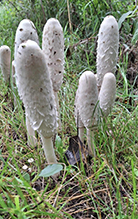 |
||
Several pillar shaped fungi popped, about 8-10 in. They changed dramatically in one day, developing a black veil the next day. |
|
|
Shaggy mane immature and with veil the following day |
||
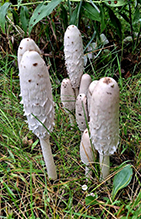 |
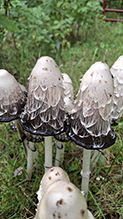 |
|
Dan W. Andree |
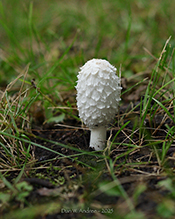 |
I believe this is a Shaggy Mane Mushroom... Some of these popped up in my backyard and the neighbors today. I think it may be a shaggy mane. A couple were turning color and getting black areas on them. It didn’t take that long for them to change color. Some were fairly darkened in areas in I would guess a couple hours or so. Seems like rain, overcast and a little cooler weather is when I see any mushrooms in my backyard area. |
Mark Holm |
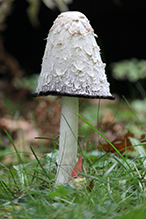 |
Shaggy inkcap Found in Cass County. |
Shayla S. |
 |
boulevard by Mayo Clinic |
Tim Marpe |
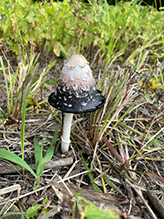 |
Luisa Isarrualde |
 |
Lucy Morrissey |
||
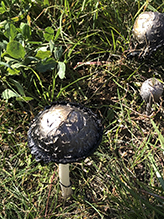 |
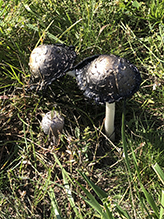 |
|
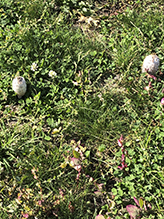 |
||
L. Mendoza |
||
 |
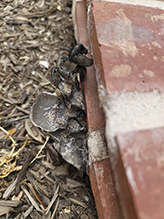 |
|
Kelsey |
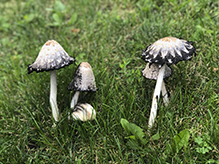 |
Kirk Nelson |
 |
Shaggy Mane in the sand dunes area near the Lyndale Trailhead, Minnesota Valley National Wildlife Refuge, Long Meadow Lake Unit |
Robert Briggs |
 |
Lawyers Cap mushroom at Black Dog Fen. The stem part alone is about 8 or 9 inches long - top to bottom the thing was easily a foot high. |
Wayne Perala |
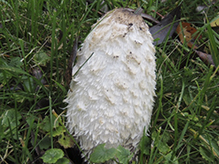 |
found in backyard 10-30-16 |
MinnesotaSeasons.com Photos
 |
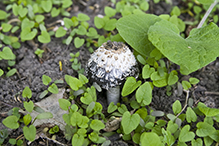 |
|
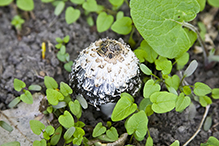 |
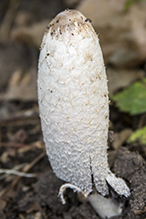 |

Slideshows
Shaggy Ink Cap Mushrooms
Andree Reno Sanborn

Visitor Videos
Share your video of this fungus.
This button not working for you?
Simply email us at info@MinnesotaSeasons.com.
Attach a video, a YouTube link, or a cloud storage link.
Other Videos
Coprinus Comatus ( The Shaggy Mane )
Jack Skrceny
Shaggy Mane Mushroom (Coprinus comatus) on Lawn
Carl Barrentine
Coprinus comatus
wetvideocamera
Shaggy Mane Mushroom (Coprinus comatus) showing autodigestion of Cap
Carl Barrentine
Timelapse da autodigestão de "Coprinus comatus" em 48 horas
Francisco Vítola

Visitor Sightings
Report a sighting of this fungus.
This button not working for you?
Simply email us at info@MinnesotaSeasons.com.
Be sure to include a location.
Gaze
10/2/2025
Location: Willmar, MN
I didn't have a phone to photograph the first Shaggy Mane mushroom I have seen! It was almost 6" tall, standing alone on disturbed soil adjacent to a sidewalk.
Luciearl
9/22 amd 9/23/2025
Location: Lake Shore, MN
Shaggy mane immature and with veil the following day
Luciearl
9/22/2025
Location: Lake Shore, MN
Several pillar shaped fungi popped, about 8-10 in. They changed dramatically in one day, developing a black veil the next day.
Dan W. Andree
9/18/2025
Location: Norman Co. Mn.
I believe this is a Shaggy Mane Mushroom...
Description: Some of these popped up in my backyard and the neighbors today. I think it may be a shaggy mane. A couple were turning color and getting black areas on them.
It didn’t take that long for them to change color. Some were fairly darkened in areas in I would guess a couple hours or so. Seems like rain, overcast and a little cooler weather is when I see any mushrooms in my backyard area.
Apricity Apricity
Fall 2021
Location: Martin County, Fairmont, MN
Kirk Nelson
8/20/2017
Location: Minnesota Valley National Wildlife Refuge, Long Meadow Lake Unit
Shaggy Mane in the sand dunes area near the Lyndale Trailhead
Robert Briggs
9/24/2016
Location: Minnesota Valley National Wildlife Refuge, Black Dog Unit
Lawyers Cap mushroom at Black Dog Fen. The stem part alone is about 8 or 9 inches long - top to bottom the thing was easily a foot high.
MinnesotaSeasons.com Sightings |

